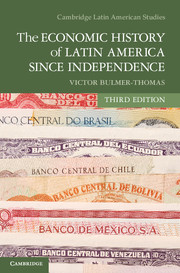Book contents
- Frontmatter
- Dedication
- Contents
- List of Tables, Figures, and Maps
- Preface to the Third Edition
- Preface to the First Edition
- List of Abbreviations
- 1 Latin American Economic Development
- 2 The Struggle for National Identity
- 3 The Export Sector and the World Economy, circa 1850–1914
- 4 Export-Led Growth
- 5 Export-Led Growth and the Nonexport Economy
- 6 The First World War and Its Aftermath
- 7 Policy, Performance, and Structural Change in the 1930s
- 8 War and the New International Economic Order
- 9 Inward-Looking Development in the Postwar Period
- 10 New Trade Strategies and Debt-Led Growth
- 11 Debt, Adjustment, and the Shift to a New Paradigm
- 12 Conclusions
- Appendix 1 Data Sources for Population and Exports before 1914
- Appendix 2 The Ratio of Exports to Gross Domestic Product, the Purchasing Power of Exports, the Net Barter Terms of Trade, and the Volume of Exports, circa 1850 to circa 1912
- Appendix 3 Population, Exports, Public Revenue, and GDP for the Main Latin American Countries before 1914
- Appendix 4 GDP Per Head in Latin America since 1900
- Bibliography
- Index
9 - Inward-Looking Development in the Postwar Period
Published online by Cambridge University Press: 05 June 2014
- Frontmatter
- Dedication
- Contents
- List of Tables, Figures, and Maps
- Preface to the Third Edition
- Preface to the First Edition
- List of Abbreviations
- 1 Latin American Economic Development
- 2 The Struggle for National Identity
- 3 The Export Sector and the World Economy, circa 1850–1914
- 4 Export-Led Growth
- 5 Export-Led Growth and the Nonexport Economy
- 6 The First World War and Its Aftermath
- 7 Policy, Performance, and Structural Change in the 1930s
- 8 War and the New International Economic Order
- 9 Inward-Looking Development in the Postwar Period
- 10 New Trade Strategies and Debt-Led Growth
- 11 Debt, Adjustment, and the Shift to a New Paradigm
- 12 Conclusions
- Appendix 1 Data Sources for Population and Exports before 1914
- Appendix 2 The Ratio of Exports to Gross Domestic Product, the Purchasing Power of Exports, the Net Barter Terms of Trade, and the Volume of Exports, circa 1850 to circa 1912
- Appendix 3 Population, Exports, Public Revenue, and GDP for the Main Latin American Countries before 1914
- Appendix 4 GDP Per Head in Latin America since 1900
- Bibliography
- Index
Summary
By the beginning of the 1950s, and even more so by the end of the Korean War, the Latin American republics were faced with a clear choice: to opt explicitly for an inward-looking model of development that would reduce their vulnerability to external shocks or to press ahead with export-led growth on the basis of some combination of export intensification and export diversification.
This choice was not made in a vacuum. Each option favored different groups within society, giving a political twist to most of the economic arguments. At the same time, international and regional institutions pressed hard to influence the outcome. Although the International Monetary Fund (IMF) favored outward-looking policies as a solution to balance-of-payments problems, the Economic Commission for Latin America (CEPAL), under the dynamic leadership of Raúl Prebisch, defended inward-looking policies. With the deterioration in the net barter terms of trade (NBTT) after the Korean War (a key feature in CEPAL's case for inward-looking development), the intellectual pendulum began to swing toward import-substituting industrialization (ISI). Yet many governments were still reluctant to abandon export-led growth altogether, in recognition of the key role still played by the export sector in economic, social, and political terms.
- Type
- Chapter
- Information
- The Economic History of Latin America since Independence , pp. 296 - 345Publisher: Cambridge University PressPrint publication year: 2014
- 1
- Cited by



